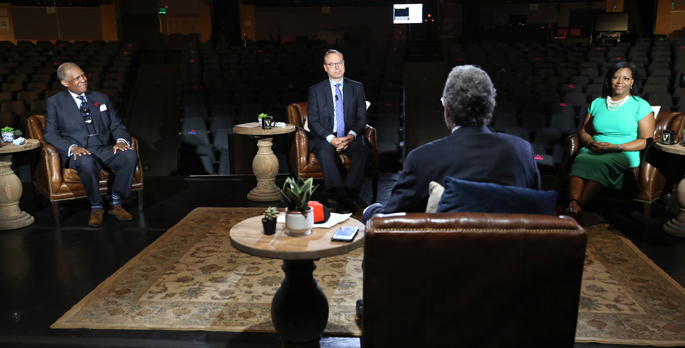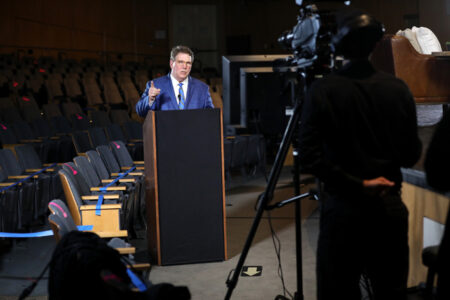
by Holly Fletcher
People are the engine that’s kept Vanderbilt University Medical Center moving forward — and setting the tone for the region on best pandemic mitigation practices — leaders said in a virtual Leadership Assembly, a new channel that is itself reflective of life and work in the pandemic era.
From masking compliance and pivoting to telehealth to spearheading COVID-19 national trials and transitioning to different job roles, the flexibility and resiliency of people at all levels of the Medical Center has been vital to ensuring operations continue to move forward even in the face of unexpected and unforeseen obstacles.
VUMC’s strong performance is attributed to each of the nearly 27,000 employees who contributed in their own ways during the final months of FY20, even as COVID-19 upended enterprise and personal plans, said both Jeff Balser, MD, PhD, President and Chief Executive Officer of Vanderbilt University Medical Center and Dean of Vanderbilt University School of Medicine, and C. Wright Pinson, MD, MBA, Deputy CEO and Chief Health System Officer.
“It’s been an extraordinary time and you have done extraordinary things,” Balser said. “We are one of the few health care systems that hasn’t had layoffs or furloughs or had to reduce salaries. A lot of it has to do with our people. We have been through challenges before and we’ve had to be resilient. Our culture causes us to pull together when times get tough — not apart. That makes a difference right now. The people of Nashville and this region are grateful to you.”
Balser wants to harness the momentum underpinning unparalleled shifts at the Medical Center to set an example for the region, and the state, in the benefits of masking compliance.
COVID-19 infection rates in Nashville are at an all-time low, which is strongly associated with mandatory masking.
Balser said he now thinks of his mask like his cell phone — it needs to be with him all the time. “That’s the new normal. If we don’t lead by example, then who will,” he said.
Here’s what you need to know about what happened in the last few months and what the new fiscal year looks like.

Performance
The pandemic upended what was on track to be a banner year for VUMC, but even in the face of unequaled challenges, the Medical Center hit threshold or better on 13 of 18 goal targets, said Pinson.
While the volatility of the last quarter made missing financial targets unavoidable, leaders are buoyed by the strength and performance of the first part of the fiscal year that softened the COVID-19 blow.
Among the highlights of the last quarter was what Pinson called “a homerun on quality.” The Medical Center hit its target on patient experience for the first time in three years, which Pinson attributed to satisfaction with telehealth and the patient portal.
Overall, the year was “a very strong performance despite the challenges we faced,” Pinson said. “It was a great performance despite the challenges that the COVID crisis presented us. It has been a remarkable year — one that no one could have predicted.”
The focus for FY21 will echo goals of the past and include making sure that leaders thank team members for their efforts and that teams are aligned on missions, so everyone is on track to focus on expanding services and improving access as well as managing expenses.
Diversity and Inclusion
The Medical Center is strengthening existing and designing new diversity and inclusion initiatives that will foster more inclusive thinking, while setting an actionable anti-racist trajectory, Balser said.
COVID-19’s disproportionate impact on Black, Latinx and immigrant communities and the death of George Floyd cast light onto where, and how, the Medical Center can do more — and accelerate the process of tackling the manifestations of systemic racism.
All VUMC leadership, including the Medical Center Board, will receive anti-racism training since recognizing what’s systemic and built into the traditional environment will “require us to have eyes” to see the components that need changing, said Balser.
A new task force will have recommendations to senior leadership by the end of the year. Among many elements are efforts already underway to identify and remove clinical traditional and widely used health care guidelines that filter treatment or tests by race, said Consuelo Wilkins, MD, MSCI, vice president for Health Equity at Vanderbilt University Medical Center and associate dean for Health Equity in the School of Medicine. The Office for Health Equity established a hub of anti-racism materials and is upgrading the training medical students receive.
VUMC has a regional opportunity to shift the conversation on unconscious bias and it’s imperative that Medical Center leadership equip themselves and the workforce to be agents of change throughout the community.
The scale of VUMC, which reaches to almost 1 in 10 people in Middle Tennessee when factoring in spouses and families, puts the Medical Center in a position to lead this initiative.
“We have the social capital to lead by example so it’s important that VUMC has this right. It is up to us to succeed here,” said Balser.
This moment is different than at times in the past because of the widespread support for social justice, said André Churchwell, MD, Levi Watkins Jr., MD Professor, Chief Diversity Officer for Vanderbilt University Medical Center, Senior Associate Dean for Diversity Affairs for Vanderbilt University School of Medicine and Vice Chancellor for Equity, Diversity and Inclusion for Vanderbilt University. He’s optimistic about the change that will stem from a coordinated, sustained effort.
“There is a social justice momentum. It’s a heterogeneous group that’s different from decades ago. It’s all ages, races, gender identities. That gives me some solace and hope for the future,” Churchwell said.
Innovation
The recalibration across the enterprise that allowed care and research to continue as the pandemic hit home is a strong foundation for progress and innovation in the coming year.
Pinson praised the adaptability across myriad departments, such as the operational initiatives to ensure labor and workforce availability, departments transitioning to remote work overnight, the creation of a health equity task force in the COVID-19 command center, and teams that quickly transitioned to taking patient access calls from home, as a handful of countless ways people made VUMC successful in the face of an unexpected challenge.
“Since the beginning of this pandemic, we are all under a threat and we have all stepped up to the plate,” Pinson said.
Day-to-day operations will continue to resemble no era of the past as the hospital, region and country watch transmission rates, hospitalization volumes and await development of effective vaccines or treatments, Pinson said.
Telehealth usage and sign-ups for My Health at Vanderbilt surged beyond targets, cementing their place as patient touchpoints, said Pinson.
- Telehealth goal: 34,680 appointments. Actual: 160,188
- My Health patient portal goal: 568,000 users. Actual: 621,153
The surge in telemedicine is “not just a technical achievement, it’s a humanitarian achievement,” said Balser, adding that he worried deeply as COVID-19 approached about how providers would stay in sync the people who need their care.
The institutional commitment to innovation is underscored in a recent decision to streamline VUMC’s strategic directions, Balser said. It’s clear that “amplifying innovation” is an integral part of all strategic directions guiding our work at the Medical Center; rather than an isolated goal, innovation is in our DNA and fuels all of our efforts toward making health care personal, he said.
To view the “This is What Caring Looks Like” video please go here.
To view the Leadership Assembly please go here.












